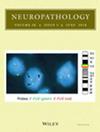A case of "genetically defined" radiation-induced glioma: 29 years after surgery and radiation for pilocytic astrocytoma.
IF 1.3
4区 医学
Q4 CLINICAL NEUROLOGY
引用次数: 1
Abstract
Radiation-induced gliomas (RIGs), which occur in a previously irradiated region of the original tumor, represent a rare but well-characterized clinical entity. They are particularly represented as secondary malignancies after irradiation for medulloblastoma (MB) and acute lymphoblastic leukemia (ALL). Clinically well recognized, their genetic characteristics have remained unclear, but recent molecular studies revealed their unifying molecular signature for the receptor tyrosine kinase 1 (RTK1) glioblastoma (GBM) subtype. We present a case of RIG that emerged 29 years after surgery and radiation for pilocytic astrocytoma (PA); the distinctive molecular features of RIGs enabled its differentiation from malignant transformation of PA. All methods and protocols related to human subjects were approved by each institution’s review board ethics committee, and the investigations were carried out in accordance with each institution’s review board-approved protocol and Declaration of Helsinki of 2013. A 33-year-old woman had a history of subtotal resection of the right temporal lobe tumor at age 3. The histopathological diagnosis of the tumor was PA, and local radiation was performed for the residual lesion with parallel opposing fields of linear accelerator (LINAC), including right temporal and frontal lobes. She presented with nausea and headache 29 years later after radiation therapy, and magnetic resonance imaging (MRI) revealed an approximately 4-cm mass with ring enhancement within the irradiated region of the right frontal lobe (Fig. 1A). The patient underwent total resection of the tumor. Histologically, the tumor showed fascicular streaming of short-spindle, astrocytic tumor cells (Fig. 1B). They displayed immunoreactivity for glial markers, including glial fibrillary acidic protein (GFAP) (mouse monoclonal, clone 6F2; Dako, Glostrup, Denmark; 1:1000) and OLIG2 (rabbit polyclonal; IBL, Gunma, Japan; 1:200). The presence of palisading necrosis and microvascular proliferation suggested high-grade astrocytic tumors, including GBM induced by radiation (Fig. 1B). Molecular testing was performed by immunohistochemistry, reverse transcription-polymerase chain reaction (RTPCR), Sanger sequencing, multiplex ligation-dependent probe amplification (MLPA), and 850 K methylation array (Infinium Methylation EPIC, Illumina), using samples from formalin-fixed paraffin-embedded (FFPE) or snap-frozen tissue. The tumor was negative for IDH1 p.R132H (mouse monoclonal, clone DIA-H09; Dianova, Hamburg, Germany; 1:500) and p53 (mouse monoclonal, clone DO-7; Nichirei Biosciences, Tokyo, Japan; pre-diluted), and alpha thalassemia/mental retardation syndrome X-linked (ATRX) (rabbit monoclonal, clone E5X7O; Cell Signaling, Danvers, MA; 1:1000) immunoreactivity was lost (Fig. 1B). Ki-67-positive ratio (mouse monoclonal, clone MIB-1; Dako; 1:500) was 20% (Fig. 1B), and MGMT promoter was unmethylated. KIAA1549::BRAF fusion was not detected by RT-PCR (Fig. S1B). Direct sequencing and MLPA showed no mutation of IDH1/2, BRAF p.V600E, or histone H3 p.K27 and p.G34 (Fig. S1A), without any of the so-called GBM genotypes (TERT promoter mutation, EGFR amplification, and 7+/10 chromosome copy number alterations), except for heterozygous PTEN deletion. DNA methylome profiling of the tumor (DKFZ classifier V12.5: https://www. molecularneuropathology.org/mnp) revealed that the case was plotted within GBM_RTK1 tumors with t-distributed stochastic neighbor embedding (t-SNE) (Fig. 1C), although the classifier confidence score was 0.26 (Table S1). There was no epigenetic evidence for PA (Fig. 1C). Copy number alteration (CNA), including platelet-derived growth factor receptor alpha (PDGFRA) (amplification), murine double minute-2 (MDM2) (amplification), and CDKN2A/B (homozygous deletion), was observed with MLPA and methylation array (Figs 1C, S1C). Additionally, partial deletion of 1p36 and 19q34, frequently observed in GBM, was also noted (Fig. 1C). Integrated diagnosis of the tumor was made as diffuse pediatric-type high-grade glioma, H3-wild type, and IDH-wild type, corresponding to RIG. RIGs were traditionally noted to consist of a heterogeneous population and could be diagnosed by exclusion of Correspondence: Kenta Masui, MD, PhD, Department of Pathology, Tokyo Women’s Medical University, Tokyo, Japan. Email: masui-kn@twmu.ac.jp一例“基因定义”的放射性神经胶质瘤:29 毛细胞星形细胞瘤手术和放疗后数年。
本文章由计算机程序翻译,如有差异,请以英文原文为准。
求助全文
约1分钟内获得全文
求助全文
来源期刊

Neuropathology
医学-病理学
CiteScore
4.10
自引率
4.30%
发文量
105
审稿时长
6-12 weeks
期刊介绍:
Neuropathology is an international journal sponsored by the Japanese Society of Neuropathology and publishes peer-reviewed original papers dealing with all aspects of human and experimental neuropathology and related fields of research. The Journal aims to promote the international exchange of results and encourages authors from all countries to submit papers in the following categories: Original Articles, Case Reports, Short Communications, Occasional Reviews, Editorials and Letters to the Editor. All articles are peer-reviewed by at least two researchers expert in the field of the submitted paper.
 求助内容:
求助内容: 应助结果提醒方式:
应助结果提醒方式:


